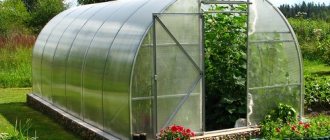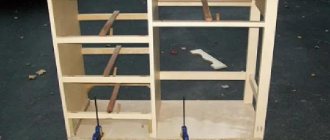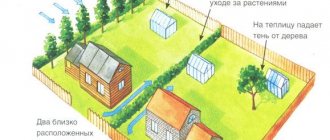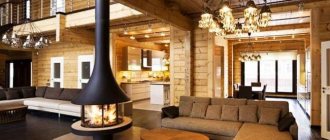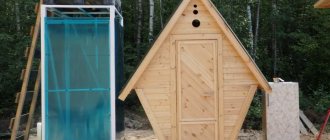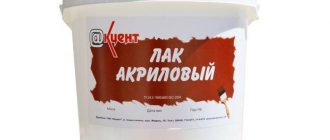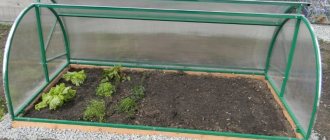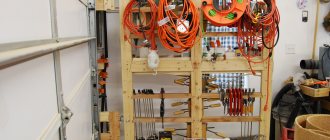What is polycarbonate
There are two types of polycarbonate - cellular and monolithic. For roofing work, as well as for the construction of auxiliary buildings on the site, including gazebos and greenhouses, the cellular version is mainly used. This is a transparent, flexible sheet material consisting of three layers:
- Upper layer . It is a sheet of polycarbonate, which is covered on top with a protective film that does not allow sunlight to destroy the material.
- The middle layer is a cellular layer. Hollow cells with polycarbonate walls give the material high thermal insulation characteristics and also make it lightweight. The walls of the cells act as a kind of stiffening ribs, due to which the material is characterized by quite high strength.
- The bottom layer is another solid sheet of polycarbonate, but without a protective coating.
Transparent polycarbonate for greenhouse Source eddi.ru
Greenhouse thermos
The main advantage of a thermos greenhouse is the ability to save energy resources and reduce heating costs, because heat is perfectly retained inside the building. This model of greenhouse is also called underground, since during construction it is buried 2-2.5 m into the ground. This gives the greenhouse a noticeable advantage - the strength of the foundation, and therefore stability even in strong gusts of wind.
Due to the fact that at such a depth in the ground a constant temperature is maintained year-round, a change in weather will not in any way affect the microclimate of the thermos greenhouse. The absence of significant temperature fluctuations in the greenhouse and a sufficient amount of light allows you to grow any crops, even exotic plant species, at any time of the year.
When constructing an underground greenhouse, it is necessary to place its ends to the west and east in order to achieve maximum lighting and heating. For this, the optimal width of the greenhouse is also important, which is 5 m (the length of the building is at your discretion). The least illuminated side can be insulated with mineral wool or polystyrene foam.
If you take a responsible and serious approach to the construction and arrangement of a greenhouse on your site, you will get a wonderful building in which you can grow vegetables, flowers, berries and other crops without any problems.
Advantages of polycarbonate greenhouses
Not so long ago, only glass and polyethylene were used to build greenhouses. In the first case, the resulting structures were heavy and fragile, which were also quite difficult to install. But the use of polyethylene film usually did not justify itself, since this material wears out quickly and also collects dirt and dust. Therefore, when the opportunity arose to make greenhouses from practical and convenient polycarbonate, many homeowners gladly took advantage of this opportunity.
The advantages of greenhouses made from new improved material are:
- strength , allowing the structure to withstand the weight of a sufficiently thick layer of snow;
- good light transmission , since all layers of the material are completely transparent and nothing prevents the sun's rays from penetrating inside;
- low thermal conductivity , thanks to which the plants in the greenhouse are protected from cold and sudden temperature changes;
- durability , which allows you to use the structure for at least 5 years without restoring or repairing it;
- light weight , allowing the use of less expensive materials for the frame and foundation as in the case of a glass greenhouse.
Polycarbonate greenhouse from the inside Source mega27.ru
See also: Catalog of companies that specialize in turnkey installation services for greenhouses and similar structures.
Foundation - we solve the problem
We will not dwell in detail on the foundation for this greenhouse. Articles on foundation construction are available on the pages of our resource (see Foundation for a polycarbonate greenhouse).
Also, we will not consider in detail the question of how to install a polycarbonate greenhouse on a foundation with your own hands.
Our task today is to assemble the greenhouse.
Assembling the greenhouse frame
This structure must be assembled as follows:
- Cut the profile to the required length for one frame
- Using self-tapping screws or rivets, assemble the first frame
- For those who have encountered gypsum plasterboard, this will not be difficult for them. In any case, if your hands are in the right place, assembling such a frame will not be a big problem.
Profile connection method.
- Carefully measure the resulting frame.
- After making sure that everything is correct, cut the entire purchased profile to the required size for all other parts.
- Assemble all the frame parts.
Frame assembly.
- Now you can connect the individual assembled frame elements into a single frame.
Method of fastening the frame.
The do-it-yourself polycarbonate frame for a greenhouse is ready.
GCR profile service life
A small digression. Some people believe that the metal gypsum board profile will not last long.
This is motivated by the fact that when cutting and drilling, the outer protective coating is damaged, into which moisture gets in, and corrosion can occur in these places, contributing to the destruction of the profile.
Our certificate is a complete misconception. The metal profile is specially designed to be cut and drilled. This does not affect its durability in any way. If polycarbonate sheets are designed to last for 15 years, a greenhouse frame made from a gypsum plasterboard profile will last no less.
We fasten polycarbonate sheets
Installing a polycarbonate greenhouse with your own hands involves installing polycarbonate sheets on a frame. Let's get to it.
There are many ways to attach polycarbonate sheets.
Correct fastening - excellent results
Regarding the fastening of polycarbonate sheets, opinions are also divided.
Some believe that polycarbonate is unsuitable for a greenhouse due to the fact that temperature changes break the tightness of the connection and warm air flows into the resulting cracks and cold air penetrates (for more information on heating a greenhouse, see Heating a polycarbonate greenhouse).
All fears and assumptions are completely in vain; the whole point is not in the polycarbonate panels themselves, but in the method of fastening it and sealing the joints.
The first method of fastening is lining
In the first case, polycarbonate sheets are attached to the greenhouse frame using overlays.
- Strips of rubber are laid on the frame of the greenhouse in the areas where the polycarbonate sheets adhere.
- Next, polycarbonate sheets are installed on the rubber pads.
- Metal plates are installed on top of the joint and secured with self-tapping screws.
- The self-tapping screw passes between two adjacent polycarbonate panels through a rubber lining.
- For additional tightness of the connection, the seams can be treated with sealant.
Second fastening method – H-profile
The second method involves the use of an H-shaped profile.
The H-shaped profile can be detachable or non-detachable.
Detachable mount.
How to secure a polycarbonate sheet using this profile is clearly visible in the figure. The only thing I would like to add is, do not be lazy for better tightness and in this case use rubber linings.
Permanent fastening.
Subtleties of fastening and installation devices
Our advice is that if you need to attach a polycarbonate sheet with a screw passing through it, use thermal washers in this case. The thermal washer will eliminate the cold bridge between the self-tapping screw and the polycarbonate sheet and additionally seals the connection. The hole in the polycarbonate sheet should be 2 - 3 mm larger than the diameter of the self-tapping screw, this achieves compensation for the expansion of the polycarbonate sheet due to climatic influences.
Our information - thermal washers are made of polycarbonate, their service life is 15 years.
Decide the step of fastening the screws yourself; of course, you shouldn’t overdo it and screw on a bunch of screws, but you shouldn’t be greedy either, everything should be in moderation. Also on our resource you can learn in detail about the assembly of such greenhouses as Orange, 2dum and Perchina.
Installing a polycarbonate greenhouse with your own hands on a foundation is best done while assembling the frame, but sometimes the frame is assembled in one place and then transferred to a prepared place. Both methods do not contradict the assembly, with the only exception: by immediately mounting the frame on the foundation, you can cope with this task alone. In the second case, you will definitely need helpers.
Which polycarbonate to choose
The main characteristics for a greenhouse are good light transmission, reliable heat retention and strength. To obtain a structure with optimal performance, polycarbonate sheets with a thickness of 4 to 10 mm should be used.
The thinner the material, the more expensive and heavier it is. Some conscientious manufacturers use polycarbonate of different thicknesses to create one design. Thus, arched elements are subject to more severe loads during strong winds and precipitation, so they are made of thicker material. Straight and side walls can be constructed from thinner polycarbonate.
Polycarbonate sheets are available in a standard width of 210 cm. Sheets can be 6 or 12 meters long. These parameters are taken into account when drawing up a drawing of the future greenhouse.
Drawing of an arched polycarbonate greenhouse Source stroymoda-nk.ru
It is worth noting that the quality of the finished greenhouse directly depends on the characteristics of the polycarbonate. At the same time, there is a large amount of counterfeit material on the market today that does not have the declared properties. This means that you should purchase finished construction or material for it only from reliable suppliers with extensive experience and an impeccable reputation.
Arched greenhouses
Below are several drawings of arched greenhouses. When creating your own, it will be useful to build on them and use them as an example. Designing semicircular greenhouses has its own interesting features.
- The height of the building is selected based on the height of the bent polycarbonate sheet. With its standard dimensions of 6x2.1 meters, the height of a small arched greenhouse will be from 1.9 to 2.1 meters. When creating a project, consider the height not only at the highest point, but also closer to the edges of the greenhouse.
- When drawing up a drawing, it is necessary to take into account the fact that a bent frame and cladding will be required. You will need to calculate the bending radius, which should not be less than the minimum radius allowed for polycarbonate. You can find it out from the seller of the material.
- Arches made of bent metal or plastic act as vertical supports. For a greenhouse 4-5 meters long, two vertical elements are enough - at the front end and at the back. For longer arcs, the arcs should be spaced at intervals of no more than one meter. The arches are screwed (or welded) to a rectangular base.
- The arcs are connected to each other using horizontal frame elements - guides. Without taking into account the base, you will need from 5 to 7 guides. One element should be located at the highest point of the greenhouse, the rest should be evenly distributed to the left and right of it.
Do-it-yourself greenhouse made of PVC pipes
In this article you will find step-by-step instructions on how to make a greenhouse from plastic pipes yourself! We also recommend reading the article on how to clean a polycarbonate greenhouse in the fall.
Frame
In order for the structure to last as long as possible, you need to choose the right material for the frame that will hold the walls of the greenhouse. The most economical option is a wooden frame. If the wood is treated with a special protective antiseptic before installation, its service life will be at least 10 years.
A frame made of a metal profile will be more reliable, but also more expensive. This is the option used by manufacturing companies. A metal frame will last longer than a wooden one, and it is much more convenient to assemble.
Types of frames depending on material
The frame is the basis of the greenhouse. It is made from different materials and their combinations. It all depends on the location where the structure will be located, operating conditions, financial capabilities of the owner and the availability of a construction team for the work.
Main frame materials:
- tree;
- metallic profile;
- galvanized pipe;
- polypropylene pipes;
- metal-plastic pipes.
Each of these options is good in certain cases. Wood is a cheap and easy to process material. But its durability is not the highest. The metal is very durable, but it promotes the formation of condensation drops, which is very harmful to plants. The same applies to galvanized pipes, but they are better than steel because they do not require anti-corrosion treatment.
It is cheaper and easier to make a greenhouse from plastic or metal-plastic pipes. The construction will be light and will not require a capital reinforced concrete foundation, like a metal frame. But, unfortunately, metal-plastic pipes do not withstand difficult weather conditions very well.
Polypropylene pipes are a favorite option for a greenhouse frame by many farmers. This is an affordable and lightweight material. Polypropylene itself is warm, which is a guarantee against the appearance of unwanted condensation. You can even install a small greenhouse from pipes alone.
Foundation
It is advisable to install the greenhouse on a foundation, despite the fact that its weight will not exceed 200 kg, and the risk of subsidence on the ground under its own weight is minimal. The fact is that, firstly, in winter, precipitation settling on the walls of the greenhouse will significantly increase its weight. In addition, if it stands without a foundation, then cold air from the street can penetrate through the gap between the soil and the walls. There are known cases when during the summer the air temperature dropped below zero at night. In a greenhouse standing on “bare” soil, all the plants can die in one night.
Another reason to make a simple foundation is that it will provide good protection from the penetration of weeds and harmful insects. And for high-quality fixation of the frame, it is also needed.
Greenhouse frames
Greenhouse frames are made of steel and aluminum. When constructing homemade structures, wooden blocks are often used. What should you pay attention to when choosing the material from which the frame is made?
- Check for the presence of a protective coating on steel frames. If it is missing, already in the second year of operation of the greenhouse you will notice the first signs of rust. This design will not last long. Frames of this type are made mainly of galvanized steel.
Steel profile frame
- When choosing an aluminum base, you need to make sure that the material is anodized. This means that there is a thin film on the surface of the metal that protects against moisture. This reduces the likelihood of corrosion.
- stationary;
- collapsible.
The process of laying a polycarbonate sheet on an aluminum frame
Many manufacturers offer greenhouses with powder-coated frames. This is a good solution to ensure the durability of the structure. Regardless of the metal processing method, aluminum frames are almost twice as expensive as steel frames. This is due to the lighter weight of the former and their maximum resistance to corrosion.
However, aluminum frames have one significant drawback. Frames made of this material are unable to withstand significant weight loads from the severity of some types of coating, as well as from snow. Therefore, in the spring you can often see greenhouses that have overwintered on the site, the racks of which are curved. This suggests that the owner did not take into account the climatic features of his region when choosing a design.
An alternative option is a wooden frame for a greenhouse
Greenhouse frame made of PVC pipes
Types of frame designs
There are two main types of greenhouse frame designs:
All-welded frame
The frame of the greenhouse or canopy is prefabricated
The first ones are optimal for those who are often at the dacha, regardless of the season. Collapsible structures are chosen by those gardeners who visit their plot only during the warm season. In this case, it makes sense to buy exactly those greenhouses that can be dismantled and stored until the start of the next season. This way you won’t have to worry about the safety of your property.
Prices and quality
The most affordable are small greenhouses (up to 5 m2) with a polyethylene awning and a frame made of powder-painted steel - 8-10 thousand rubles. The same structures, but with a polycarbonate coating, will cost about 50% more – up to 15 thousand rubles. The most expensive are glass greenhouses. These structures are mounted only on the basis of reliable steel frames. A glass greenhouse with an area of up to 5 m2 will cost a little more than 20 thousand rubles.
The price depends on various parameters - in particular, on:
- the presence or absence of windows to ventilate the interior of the greenhouse;
- number of doors;
- thickness and type of coating;
- frame material;
- design forms.
Greenhouses made of polycarbonate are considered the most practical and high-quality. They are almost 200 times stronger and more reliable than glass. The least number of positive reviews about polyethylene greenhouses. They serve, as a rule, no more than 1-2 summer seasons.
Optimal width and length of the greenhouse
The size of the greenhouse must correspond to the area of the site and its purpose. It should be taken into account that it should not be covered with shadow from other objects, and next to it you need to leave space for open beds. Experienced gardeners recommend the following greenhouse sizes:
- wall height – from 160 cm;
- width – from 235 cm;
- length – from 6 meters (corresponding to the length of the polycarbonate sheet).
It should be taken into account that with a wall height of 160 cm, the ridge will be located much higher. The minimum width is calculated for two beds and a passage between them. If you have the desire and opportunity to have a greenhouse with several beds, you can make it wider. So, each additional bed will take another 1 meter + 35 cm per passage.
The length of the greenhouse can be quite large, but it is advisable to plan it as a multiple of 6 meters - along the length of the sheet of material. The best option is to build an elongated shape into two beds with a walkway. The more plants you plan to grow, the longer the greenhouse and the beds in it should be. However, if it is impossible to allocate a long, elongated section of the yard for the structure, you can build a square or even round greenhouse.
Compact square greenhouse Source mojateplica.ru
Greenhouse shape
Polycarbonate greenhouses are manufactured in several standard configurations. They are single-pitch, gable, arched and teardrop-shaped.
Single-pitch
A structure with a pitched roof can be either free-standing or wall-mounted. The wall option is ideal for small areas. The advantages of such a greenhouse:
- good thermal insulation;
- economical consumption of materials;
- ease of installation.
There are also obvious disadvantages:
- the wall of the house does not allow the greenhouse to fully warm up;
- the structure may be damaged by snow or ice falling from the roof of the house.
Polycarbonate lean-to greenhouse Source vi.decorexpro.com
Gable
A design reminiscent of a classic house. Suitable in cases where you need to build a polycarbonate greenhouse whose dimensions are larger than average. Has the following advantages:
- maximum usable area;
- allows you to grow tall plants;
- good light transmission;
- simplicity in the arrangement of the ventilation system.
Minuses:
- increased consumption of materials, which is reflected in the final cost of the structure;
- it is necessary to ensure that sealing is maintained at the junction of the slopes and walls.
Gable greenhouse made of polycarbonate Source sbgreenhouse.com
Arched
The most practical form. There is no joint between the walls and the roof part, and at the same time, the arc-shaped configuration contributes to the rapid and effective removal of sediment.
Advantages:
- an arched building can be of any size, since it is easy to assemble a frame to fit any dimensions;
- high resistance to wind load;
- mobility - it can be easily dismantled and installed in another place;
- low consumption of materials.
Disadvantages:
- not suitable for growing tall crops;
- it is difficult to arrange ventilation.
Arched polycarbonate greenhouse Source stroyportal.ru
teardrop-shaped
Drop-shaped greenhouses have the most aesthetic design. They combine the characteristics of an arched and gable structure.
Advantages:
- increased strength;
- precipitation drains well from the surface of the structure;
- high light transmittance.
Flaws:
- difficulty of assembly;
- high price.
There are also more original forms of such structures. For example, you can build a mini-greenhouse with an opening top in the form of a breadbox or a round domed greenhouse. The choice depends on the requirements for the design. The most practical options are gable and arched shapes.
Drop-shaped greenhouse made of polycarbonate Source ro.decorexpro.com
Advantages of cellular polycarbonate for covering greenhouses
Polycarbonate was synthesized in 1953 by German chemist Hermann Schnell and American Daniel Fox almost simultaneously. They worked in different countries, but mysteriously got the same result. The controversial situation was resolved in favor of the American company General Electric. It took another 20 years to create cellular polycarbonate with a cellular structure through various transformations. Now it is widely used for the manufacture of technologically advanced translucent structures and coatings.
The material is produced in the form of sheets with a thickness of 3-25 mm. It can be either colorless or colored. To cover greenhouses, transparent cellular polycarbonate with a thickness of 3.5-6 mm is used. Thinner panels are too fragile, do not resist loads well and do not last long. You can also make a greenhouse from polypropylene pipes, but this will be discussed in detail in another article.
Cellular polycarbonate has valuable qualities that make it a worthy alternative to glass:
- high light transmittance, reaching 85%, which is only 3-5% less than that of conventional inorganic glass;
- lightness - the mass of one square meter. meter does not exceed 1.4 kg, in comparison with glass it is 6-10 kg lower;
- flexibility, allowing to cover arched or hipped structures with a bend radius of 0.8-1.3 m;
- low thermal conductivity of 0.2 W/m°C (5 times less than glass).
Since all polymers are prone to rapid aging under the influence of ultraviolet radiation, the outer side of the sheet is protected with a special film. Polycarbonate is resistant to chemical attack, frost, heat, and high humidity.
Characteristics of cellular polycarbonate
Another important advantage of polycarbonate is that upon impact it does not break into sharp fragments like glass. Thanks to their viscous structure, the particles remain connected and do not fly apart with the risk of injuring others.
